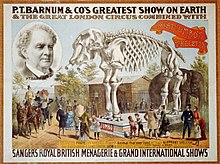Jumbo
[5] In the following years, Jumbo became a crowd favorite due to his size, and would give rides to children on his back, including those of Queen Victoria.
The sale of Jumbo, however, sent the citizens of London into a panic, because they viewed the transaction as an enormous loss for the British empire.
[a] John Ruskin, a fellow of the Zoological Society, wrote in The Morning Post in February 1882: "I, for one of the said fellows, am not in the habit of selling my old pets or parting with my old servants because I find them subject occasionally, perhaps even "periodically," to fits of ill temper; and I not only "regret" the proceedings of the council, but disclaim them utterly, as disgraceful to the city of London and dishonourable to common humanity.
In New York, Barnum exhibited Jumbo at Madison Square Garden, earning enough in three weeks from the enormous crowds to recoup the money he spent to buy the animal.
[11][12][13] Barnum told the (possibly fictional) story that Tom Thumb, a young circus elephant, was walking on the railroad tracks and Jumbo was attempting to lead him to safety.
According to newspapers, the freight train hit Jumbo directly, killing him, while Tom Thumb suffered a broken leg.
[14][15] Many metallic objects were found in the elephant's stomach, including English pennies, keys, rivets, and a police whistle.
After touring with Barnum's circus,[17] the skeleton was donated to the American Museum of Natural History in New York City, where it remains.
[18] Ashes from that fire, which are believed to contain the elephant's remains, are kept in a 14-ounce Peter Pan Crunchy Peanut Butter jar in the office of the Tufts athletic director, while his taxidermied tail, removed during earlier renovations, resides in the holdings of the Tufts Digital Collections and Archives.
Modern authorities do not recognize this (or any other subspecies of African bush elephants), considering its purportedly diagnostic large size and peculiarly shaped ears to be individual variation.
Barnum Hall, a superstition held that dropping a coin into a nostril of the trunk would bring good luck on an examination or sports event.
[21] Although the hide was destroyed by a major fire,[18] Jumbo remains the mascot of Tufts, and representations of the elephant are featured prominently throughout the campus.
[22] St. Thomas's Railway City Brewery sells an IPA beer named Dead Elephant.
[24] Built by James V. Lafferty in 1881, Lucy is the oldest surviving roadside tourist attraction in America and a National Historic Landmark.










